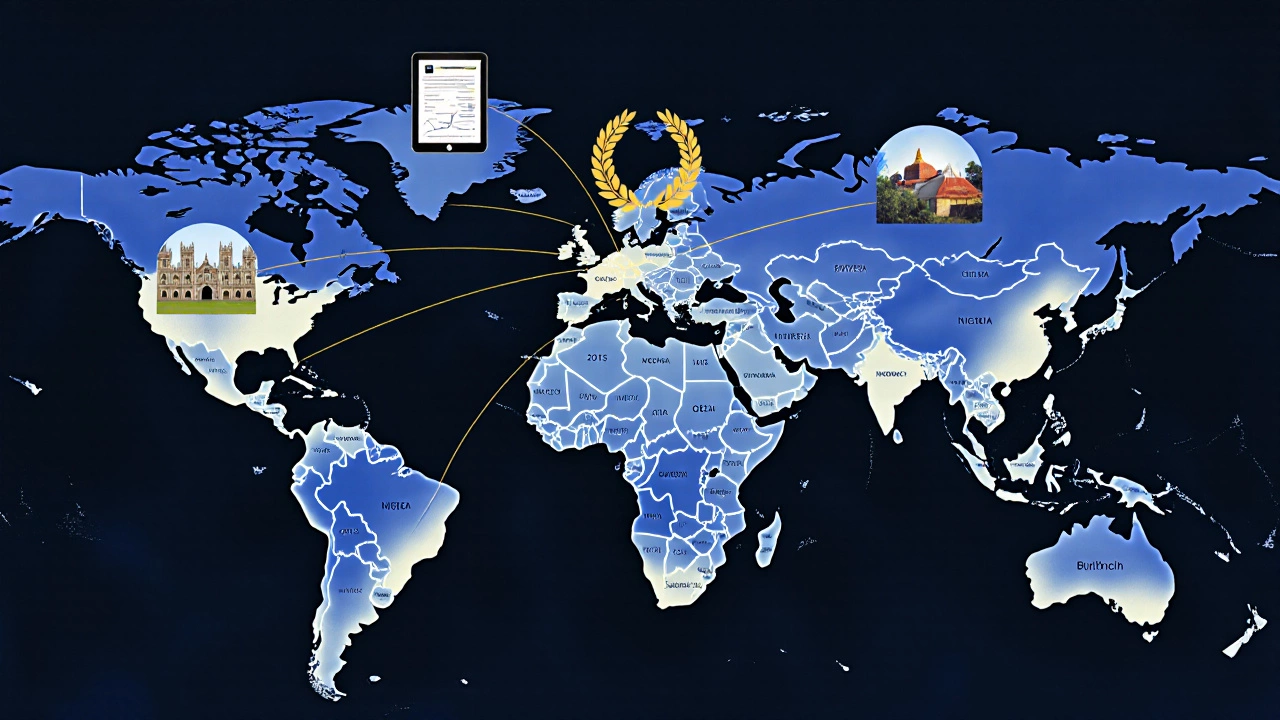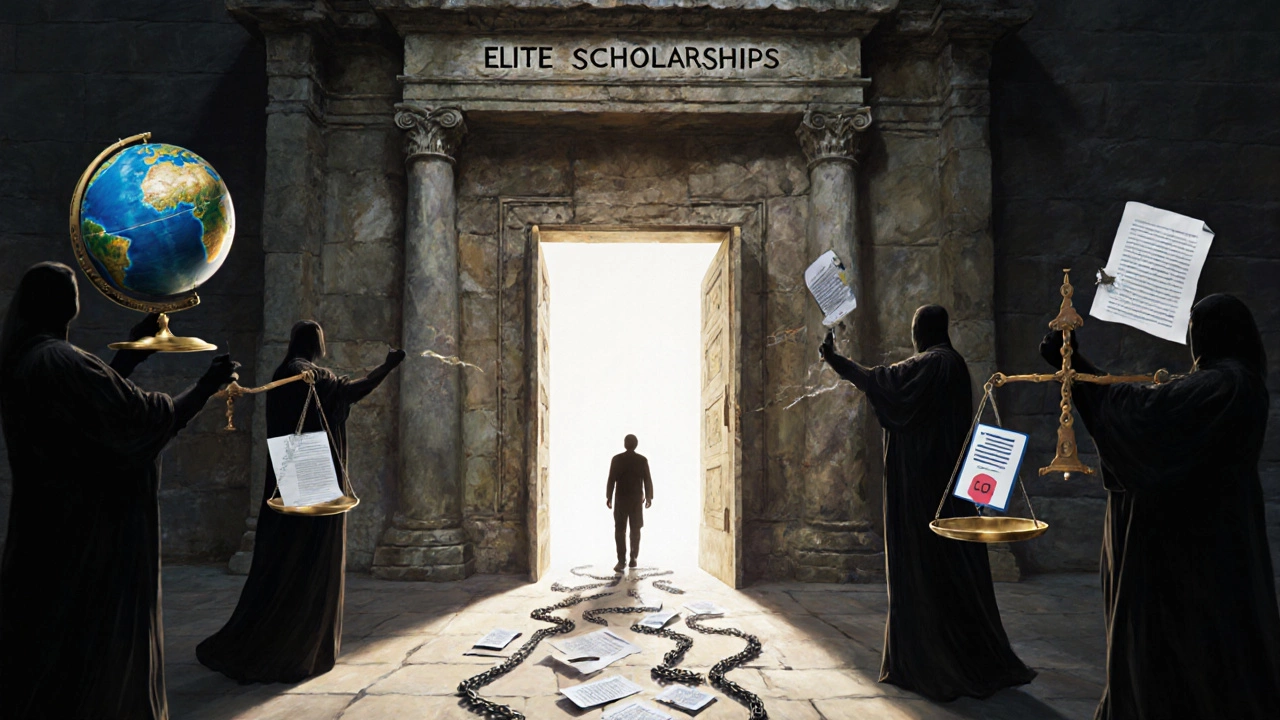Scholarship Difficulty Calculator
The hardest scholarships require extraordinary achievements. This tool estimates your odds based on application statistics and your qualifications.
Your Application Profile
Scholarship Difficulty Factors
These elite scholarships seek not just high achievers but changemakers. They look for:
- Extraordinary impact 10/10
- System-changing ideas 9/10
- International perspective 8/10
- Original research 10/10
Results
Requires extraordinary leadership, research, and character. Key factor: Proven impact beyond academics.
Global competition with system-changing projects. Key factor: International impact with measurable results.
Varies by country (3-15% success rate). Key factor: Deep cultural engagement and research potential.
STEM research excellence required. Key factor: Published work and original contributions.
Key Insight
Elite scholarships don't reward achievement—they reward extraordinary impact. You don't need a perfect GPA; you need to change the game.
Start building your track record now: Document your impact, find mentors, and create tangible projects that solve real problems.
There are thousands of scholarships out there - some for $500, some for full tuition, some for athletes, artists, or kids who grew up on farms. But if you’re asking which one is the hardest type of scholarship to get, you’re not just looking for a list. You want to know which ones are so rare, so selective, that getting one feels like winning the lottery with a single ticket.
It’s not about the money - it’s about the pool
A scholarship that gives $50,000 a year sounds impressive. But if 5,000 people apply, your odds are 1 in 100. That’s tough, but doable. The real monsters are the ones where fewer than 100 people even apply - and only 5 get picked. These aren’t just scholarships. They’re invitations to join an elite group that changes the world.The hardest scholarships don’t just reward grades. They look for people who’ve already done something extraordinary - published research before college, led humanitarian projects in conflict zones, invented something used in classrooms across three countries. They want future leaders, not just high achievers.
The Rhodes Scholarship: The original gold standard
Founded in 1902, the Rhodes Scholarship sends about 100 students a year to the University of Oxford. It’s open to citizens from over 20 countries, including the U.S., Canada, Australia, and dozens in Africa and Asia. But here’s the catch: in the U.S. alone, around 2,000 applicants compete for just 32 spots. That’s a 1.6% success rate.It’s not about having the highest GPA. One winner in 2023 had a 3.8 GPA but had built a nonprofit that trained 500 refugee women in coding. Another had published peer-reviewed papers in physics while still in high school. The selection panel looks for intellectual curiosity, moral character, leadership, and physical vigor - yes, they still ask about sports and outdoor activities.
There’s no application portal you can just click through. You need endorsements from your university, a personal statement that doesn’t sound like a resume, and an interview with a panel of former Rhodes scholars. Many applicants spend months preparing. And still, 98% don’t make it.
The Gates Cambridge Scholarship: Global, but brutally selective
This one is often confused with the Gates Scholarship in the U.S., but it’s a different beast. The Gates Cambridge Scholarship funds around 80 international students each year to study at the University of Cambridge. It covers the full cost of tuition, living expenses, airfare, and even research grants.What makes it harder than the Rhodes? The applicant pool is global. In 2024, over 4,000 people from 120 countries applied. Only 82 were selected. That’s a 2% acceptance rate - and that’s after being nominated by their home institutions. Many universities only nominate one or two students per year.
They don’t just want smart people. They want people who will change systems. A 2023 recipient worked on reducing maternal mortality in rural India using AI-powered diagnostics. Another developed a low-cost water purification system now used in 17 African countries. The scholarship doesn’t fund students who want to become doctors - it funds doctors who will redesign healthcare.

The Fulbright Program: More applicants, but harder to win abroad
The Fulbright is the largest U.S. international exchange program. It sends students, scholars, and professionals to over 160 countries. On paper, it seems accessible - over 8,000 people apply each year. But here’s the twist: the acceptance rate varies wildly by country.Applying to study in the U.K., Germany, or France? Acceptance rates hover around 10-15%. But apply to go to Indonesia, Nigeria, or Bhutan? The odds drop to 3-5%. Why? Because those countries have fewer applicants - but also fewer spots. And the selection committee wants people who will truly engage with the culture, not just study there.
One applicant in 2024 spent a year learning Arabic in Cairo before applying. She didn’t just want to study education reform - she wanted to live with a host family, teach English in a village school, and write a documentary. That’s the kind of depth Fulbright rewards.
The Churchill Scholarship: For science and engineering geniuses
If you’re an American student with a passion for STEM, the Churchill Scholarship might be your hardest shot. It sends 15 students each year to the University of Cambridge to pursue a one-year master’s in science, mathematics, or engineering.It’s not just about being good at math. You need to have already done original research - published papers, patents, or lab work that’s been cited by others. In 2023, the average GPA of winners was 3.97. But half of them had already co-authored journal articles before graduating college.
The interview is brutal. You’ll be asked to explain your thesis to a panel of Nobel laureates. One winner recalled being asked, ‘If your research failed tomorrow, what would you do next?’ - not to test knowledge, but to see if they had grit.
Why are these so hard? The real reason
You might think these scholarships are hard because they’re prestigious. But that’s backwards. They’re prestigious because they’re hard. The reason they have such low acceptance rates is simple: they’re not designed for the average student. They’re designed for the one-in-a-thousand.These programs don’t want people who worked hard. They want people who changed the game. They don’t want people who got good grades. They want people who asked new questions.
And here’s the thing - most students don’t even know these exist until senior year. By then, it’s too late to build the kind of track record they’re looking for. The real secret? Start early. Don’t wait until you’re applying. Build something meaningful now. Publish a paper. Lead a project. Volunteer abroad. Fix a problem in your community. These scholarships don’t reward what you did last year. They reward what you’ve been doing for the last five years.

What about the Gates Scholarship in the U.S.?
A lot of people mix this up with the Gates Cambridge. The U.S.-based Gates Scholarship is for low-income, high-achieving students of color. It’s extremely competitive too - around 300 winners out of 30,000 applicants - but it’s more accessible in one way: you don’t need to have published research or led international projects. You need to have overcome real barriers and show leadership in your community. It’s hard, but for different reasons.What can you do if you’re not eligible?
If you’re not a U.S. citizen, don’t have a 4.0 GPA, or haven’t led a global initiative - don’t give up. These elite scholarships aren’t the only path. There are hundreds of smaller, less-known scholarships that are just as life-changing.Look for ones tied to your heritage, your hometown, your major, or your hobbies. A scholarship for left-handed violinists? Yes, that exists. One for students who raise chickens? Also yes. The key isn’t to chase the hardest - it’s to find the ones that match your story.
Final reality check
The hardest scholarships to get aren’t the ones with the biggest payouts. They’re the ones that ask you to be more than a student. They ask you to be a changemaker - and they want proof, not promises.So if you’re aiming for one of these, don’t just apply. Build your case over years. Document your impact. Find mentors who’ve done it before. And remember: even if you don’t win, the work you do trying to get in will open doors no scholarship ever could.
